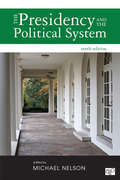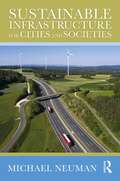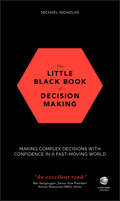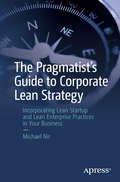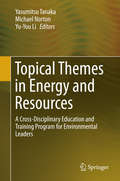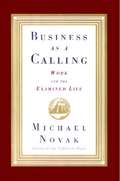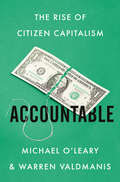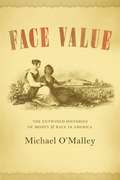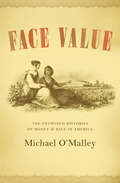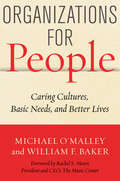- Table View
- List View
The Presidency and the Political System
by Michael NelsonPresidency and the Political System showcases the best of presidential studies and research with top-notch presidential scholars writing specifically for an undergraduate audience. Editor Michael Nelson, a well-known, well-respected presidency scholar, rigorously edits each contribution to meet his exacting standards for the volume and offers contextual headnotes introducing each essay. Essays cover approaches to studying the presidency, elements of presidential power, presidential selection, presidents and politics, and presidents and government.
Sustainable Infrastructure for Cities and Societies
by Michael NeumanThe central role of infrastructure to cities, and in particular their sustainability, is essential for proper planning and design since most energy and materials are themselves consumed by or through infrastructures. Moreover, infrastructures of all types affect matters of economic and social equity, due to access that they provide or prevent. Sustainable Infrastructure for Cities and Societies shows how fundamental planning, design, finance, and governance principles can be adapted for sustainable infrastructure to provide solutions to make cities significantly more sustainable. By providing a contemporary overview on infrastructure, cities, planning, economies, and sustainability, the book addresses how to plan, design, finance, and manage infrastructure in ways that reduce consumption and harmful impacts while maintaining and improving life quality. It considers the interrelationships between the economic, political, societal, and institutional frameworks, providing an integrative approach including livability and sustainability, principles and practice, and planning and design. It further translates these approaches that professionals, policymakers, and leaders can use. This approach gives the book wide appeal for students, researchers, and practitioners hoping to build a more sustainable world.
The Little Black Book of Decision Making: Making Complex Decisions with Confidence in a Fast-Moving World
by Michael NicholasThe secret to making the right call in an increasingly complex world The decisions we make every day – frequently automatic and incredibly fast – impact every area of our lives. The Little Black Book of Decision Making delves into the cognition behind decision making, guiding you through the different ways your mind approaches various scenarios. You'll learn to notice that decision making is a matter of balance between your rational side and your intuition – the trick is in honing your intuition to steer you down the right path. Pure reasoning cannot provide all of the answers, and relying solely on intuition could prove catastrophic in business. There must be a balance between the two, and the proportions may change with each situation. This book helps you quickly pinpoint the right mix of logic and 'gut feeling,' and use it to find the best possible solution. Balance logic and intuition in your decision making approach Avoid traps set by the mind's inherent bias Understand the cognitive process of decision making Sharpen your professional judgement in any situation Decision making is the primary difference between organisations that lead and those that struggle. The Little Black Book of Decision Making helps you uncover errors in thinking before they become errors in judgement.
The Pragmatist's Guide to Corporate Lean Strategy: Incorporating Lean Startup And Lean Enterprise Practices In Your Business
by Michael NirUse this practical, step-by-step guide on lean agile strategy to harness technological disruption at your large business to successfully advance your business rather than suffer a loss of business. The lean agile enterprise concept is demystified and translated into action as the author shares his experience with both success and major failure in areas such as healthcare, insurance, major airline, manufacturing, financial services, education, and big data. The author shares the good, the bad, and the ugly of enterprise-level adoption of lean startup practices (what we call a “lean corporation”). The book provides step-by-step instructions specifically targeted to technologists in multiple roles—from CEO to a developer on the ground—on how to build a “lean agile corporation” and avoid common traps. Building on the experience of the “lean startup” framework of Steven Blank and Eric Reis, this book takes these concepts to the enterprise level by providing tips and best practice guidelines, sharing “horror stories” and common anti-patterns in a fun and engaging way. What You'll Learn Discover how you can contribute to your company as it becomes a lean agile corporation and survives technological and digital disruptionBeat Facebook, Amazon, Apple, and Google at their own game by using methods they use to quickly experiment with new services and features Understand how to advance your career in a lean startup frameworkKnow how you can trace your company’s success to your daily work Who This Book Is ForThose in technology and business who are interested in strategy, business agility, management, execution, new technologies, and in the future of the business world.
1worker1vote: MONDRAGON in the US
by Rebecca Henderson Michael NorrisMONDRAGON, the largest cooperative in the world, and the inspiration for several U.S. cooperatives, faces a challenge in 2013 after one of its largest cooperatives votes to leave the group and another goes bankrupt.
1worker1vote: MONDRAGON in the US
by Michael Norris Rebecca M. HendersonMONDRAGON, the largest cooperative in the world, and the inspiration for several U.S. cooperatives, faces a challenge in 2013 after one of its largest cooperatives votes to leave the group and another goes bankrupt.
Bank of America: Mobile Banking (Abridged)
by Michael Norris Sunil GuptaIn January 2010, Bank of America is discussing their future mobile strategy. Should the company add complexity to their app, design multiple apps for business segments, or expand into other mobile channels?
Bloodbuy
by Michael Norris Richard G. HamermeshIn 2015, Chris Godfrey, founder and CEO of Bloodbuy has to consider the best path to growth for his young company that is attempting to disrupt the blood donation industry.
Building a Social Media Culture at Dell
by Michael Norris Rohit DeshpandeAs Michael Dell refocused his newly-private company on services and solutions, the entire corporation was pushed to embrace social media.
Ken Traub at American Bank Note Holographics
by Michael Norris Suraj SrinivasanKen Traub is hired as CFO for American Bank Note Holographics, the market-leading security holograph company in January 1999, but discovers on his first day that the company has misstated its financials and resigns. After consulting with the company for the next several weeks as it announces its misstatements to the public, he is asked to become president of the company. Should he take the job or is the company a sinking ship?
MINTing Innovation at NewYork-Presbyterian (B)
by Michael Norris Richard G. HamermeshThis short (B) case gives an update on the progess that MINT has made at NYP since the end of the (A) case.
Streaming Over Broadband: Why Doesn't My Netflix Work?
by Shane Greenstein Michael NorrisIn late 2013 and early 2014, Netflix service over the major U.S. Internet Service Providers (ISPs) suffered major slowdowns. What were the causes of these problems? What could Netflix do to solve them?
Streaming Over Broadband: Why Doesn't My Netflix Work?
by Shane Greenstein Michael NorrisIn late 2013 and early 2014, Netflix service over the major U.S. Internet Service Providers (ISPs) suffered major slowdowns. What were the causes of these problems? What could Netflix do to solve them?
The I-PASS Patient Handoff Program
by Robert S. Huckman Michael NorrisIn 2015, the I-PASS Patient Handoff Program Team, led by six pediatricians around the U.S., had to determine the best way to disseminate their program that had been proven to reduce communication errors in patient handoffs in hospital settings. Should they turn it into a standalone business, continue publishing in academic journals, license their content to an established medical vendor, or do some combination of these? This case allows students to develop and evaluate approaches to disseminating simple and proven innovations with complex service settings.
U.S. Digital Service
by Michael Norris Mitchell Weiss Nick SinaiMikey Dickerson and Haley Van Dyck found themselves far from home and far from certainty about where to take the U.S. Digital Service (USDS) next. In the summer of 2015, they had landed in London to meet with Mike Bracken, director of the United Kingdom's Government Digital Service (GDS). In 2014, President Barack Obama had given USDS a monumental task: transform how the federal government worked for the American people, digitally. The seeds of USDS had grown out of the rescue of HealthCare.gov, the federal website meant to allow consumers to shop for private health insurance. Its launch and crash in October 2013 had threatened one of Obama's signature policy achievements. Dickerson and a small team had been drafted to help fix HealthCare.gov and had successfully done so in a matter of months. While in London, Dickerson and Van Dyck wondered, of the other areas that most cried out for new technology approaches, which should be tackled next? Moreover, GDS had embedded satellite teams into the U.K.'s government agencies to guide, assist, and in some cases control, each agency's digital presence. Did London hold lessons for if, and how, these teams could be successful in the U.S. government? USDS had begun to experiment with this model too, embedding teams in a handful of departments in the U.S federal government. How could USDS best work with the dozens of agencies that were actually doing the work of government?
U.S. Digital Service
by Michael Norris Nick Sinai Mitchell B. WeissMikey Dickerson and Haley Van Dyck found themselves far from home and far from certainty about where to take the U.S. Digital Service (USDS) next. In the summer of 2015, they had landed in London to meet with Mike Bracken, director of the United Kingdom's Government Digital Service (GDS). In 2014, President Barack Obama had given USDS a monumental task: transform how the federal government worked for the American people, digitally. The seeds of USDS had grown out of the rescue of HealthCare.gov, the federal website meant to allow consumers to shop for private health insurance. Its launch and crash in October 2013 had threatened one of Obama's signature policy achievements. Dickerson and a small team had been drafted to help fix HealthCare.gov and had successfully done so in a matter of months. While in London, Dickerson and Van Dyck wondered, of the other areas that most cried out for new technology approaches, which should be tackled next? Moreover, GDS had embedded satellite teams into the U.K.'s government agencies to guide, assist, and in some cases control, each agency's digital presence. Did London hold lessons for if, and how, these teams could be successful in the U.S. government? USDS had begun to experiment with this model too, embedding teams in a handful of departments in the U.S federal government. How could USDS best work with the dozens of agencies that were actually doing the work of government?
Weathering the Storm at NYU Langone Medical Center
by Robert S. Huckman Michael Norris Rafaella SadunIn the fall of 2012, Hurricane Sandy forced a full evacuation of NYU Langone Medical Center in New York City. The institution, which comprised NYU Medical School and several teaching hospitals, had been on an upward trajectory for several years under the leadership of Dr. Robert I. Grossman. Grossman's central initiative, which he credited with helping to create a performance-driven, transparency-focused culture was an information technology dashboard system that provided managers and front line workers with a wealth of real-time information. Would the disruption posed by the hurricane throw NYU Langone off track?
Weathering the Storm at NYU Langone Medical Center
by Robert S. Huckman Michael Norris Raffaella SadunIn the fall of 2012, Hurricane Sandy forced a full evacuation of NYU Langone Medical Center in New York City. The institution, which comprises NYU Medical School and several teaching hospitals, had been on an upward trajectory for several years under the leadership of Dr. Robert I. Grossman. Grossman's central initiative, which he credited with helping to create a performance-driven, transparency-focused culture was an information technology dashboard system that provided managers and front line workers with a wealth of real-time information. Would the disruption posed by the hurricane throw NYU Langone off track?
Sustainability: Duty or Opportunity for Business?
by Michael NortonBusinesses are expected to act sustainably; it is also in both societal and their interests if businesses seek and grasp opportunities to develop more sustainable products or services. Leading international companies may already be moving in this direction, but many (especially smaller companies) are often held back by a lack of personnel or know how. This book has been written to overcome this deficit by providing a convenient ‘one-stop-shop’ where readers (whether they be business staff, university or business school student) can understand personally what the sustainability issue is about, and appreciate the many areas where companies can respond to the challenge of a more sustainable world. Based on a successful ‘Green’ Management of Technology Masters introduced in Japan in 2008, this book explains in non-specialist language why current economic systems under which firms operate do not lead to sustainable outcomes, provides the background and evolution of concerns over sustainability and the many potential opportunities for businesses. It also provides sufficient understanding of key environmental and social issues to support informed debate, and encourages readers to consider working for a more sustainable organisation and society. The book provides an overview of the internal business issues raised by concerns over sustainability, and the many external opportunities which exist for innovation and development of new products and services, which can contribute to both company viability and a sustainable future for society. It can either be used as a basis for self-study and learning, or as a textbook to support a course in an MBA, MOT or similar business-oriented course. It includes educational feedback from the course students (mostly working in local businesses), which may encourage readers to explore the interactions between sustainability and business, and help teachers planning and implementing similar courses. It also blends together case studies from both UK and Japan providing a genuinely trans-national perspective.
Topical Themes in Energy and Resources
by Michael Norton Yasumitsu Tanaka Yu-You LiThis book combines issues several critical ones in the energy field (low-energy technologies, renewable energies such as the hydrogen economy, and geothermal energy). Moving towards a more sustainable world requires a complete revolution in the way we manage energy and resources. However, from an academic perspective, this theme is so broad that most educators and researchers tend to focus on just one aspect, and maintaining the broad viewpoint which is necessary for making strategic judgments becomes difficult. Tohoku University addressed this challenge when developing a new education and training program for environmental leaders and brought together the extensive range of expertise available in specific fields into one special course which forms the basis of this book. Now in one volume, both students and educators can be brought up to date on a wide range of critical issues currently being addressed in the field of energy and resources. Chapters on resources include availability (for instance, rare earth metals), extraction and recycling of metals and plastics, and technological solutions to specific waste-disposal problems. In addition, broader strategic issues such as limits to growth and the interaction between the economic system and environmental issues are addressed. Even though each chapter provides topical data and knowledge from disparate and specialized fields, the book is written at a level that is readily understandable by students from all scientific, engineering, and humanities fields.
Business as a Calling: Work and the Examined Life
by Michael NovakThis book is a spiritual feast, for everyone who wants to examine how to make a life through making a living.
Accountable: The Rise of Citizen Capitalism
by Michael O'Leary Warren Valdmanis“More than ever before, this is the book our economy needs.” – Dr. Rajiv Shah, president of the Rockefeller Foundation“Unwilling to settle for easy answers or superficial changes, O’Leary and Valdmanis push us all to ask more of our economic system.” – Senator Michael F. BennetThis provocative book takes us inside the fight to save capitalism from itself.Corporations are broken, reflecting no purpose deeper than profit. But the tools we are relying on to fix them—corporate social responsibility, divestment, impact investing, and government control—risk making our problems worse.With lively storytelling and careful analysis, O’Leary and Valdmanis cut through the tired dogma of current economic thinking to reveal a hopeful truth: If we can make our corporations accountable to a deeper purpose, we can make capitalism both prosperous and good.What happens when the sustainability-driven CEO of Unilever takes on the efficiency-obsessed Warren Buffett? Does Kellogg’s—a company founded to serve a healthy breakfast—have a sacred duty to sell sugary cereal if that’s what maximizes profit? For decades, government has tried to curb CEO pay but failed. Why? Can Harvard students force the university to divest from oil and gas? Does it even matter if they do?O’Leary and Valdmanis, two iconoclastic investors, take us on a fast-paced insider’s journey that will change the way we look at corporations. Likely to spark controversy among cynics and dreamers alike, this book is essential reading for anyone with a stake in reforming capitalism—which means all of us.
Face Value: The Entwined Histories of Money and Race in America
by Michael O'MalleyFrom colonial history to the present, Americans have passionately, even violently, debated the nature and the character of money. They have painted it and sung songs about it, organized political parties around it, and imprinted it with the name of God--all the while wondering: is money a symbol of the value of human work and creativity, or a symbol of some natural, intrinsic value? In Face Value, Michael O'Malley provides a deep history and a penetrating analysis of American thinking about money and the ways that this ambivalence unexpectedly intertwines with race. Like race, money is bound up in questions of identity and worth, each a kind of shorthand for the different values of two similar things. O'Malley illuminates how these two socially constructed hierarchies are deeply rooted in American anxieties about authenticity and difference. In this compelling work of cultural history, O'Malley interprets a stunning array of historical sources to evaluate the comingling of ideas about monetary value and social distinctions. More than just a history, Face Value offers us a new way of thinking about the present culture of coded racism, gold fetishism, and economic uncertainty.
Face Value: The Entwined Histories of Money and Race in America
by Michael O'MalleyThe cultural historian and author of Keep Watching analyses American ideas about race, money, identity, and their surprising connections through history. From colonial history to the present, Americans have passionately, even violently, debated the nature and of money. Is it a symbol of the value of human work and creativity, or a symbol of some natural, intrinsic value? In Face Value, Michael O&’Malley provides a penetrating historical analysis of American thinking about money and the ways that this ambivalence intertwines with race. Like race, money is bound up in questions of identity and worth, each a kind of shorthand for the different values of two similar things. O&’Malley illuminates how these two socially constructed hierarchies are deeply rooted in American anxieties about authenticity and difference. In this compelling work of cultural history, O&’Malley interprets a wide array of historical sources to evaluate competing ideas about monetary value and social distinctions. More than just a history, Face Value offers a new way of thinking about the present culture of coded racism, gold fetishism, and economic uncertainty. &“This is a &‘big idea&’ book that no one but Michael O&’Malley could even have thought of—much less pulled off with such nuance and clarity.&”—Scott A. Sandage, author of Born Losers
Organizations for People: Caring Cultures, Basic Needs, and Better Lives
by Michael O'Malley William F. BakerFor many years, there has been quite a bit of talk about employee engagement as a means to lift corporate profits and reduce absenteeism and turnover. However, this talk has not produced better companies. In fact, the evidence shows that incivility and instances of employee abuse are getting worse. Additionally, with profit as the primary goal of organizations, most employees view any benign treatment they receive as a secondary convenience that will dissipate once corporate fortunes decline. That is, many employees still believe they are expendable in the eyes of their employers. This book turns that equation around by examining the practices of twenty-one companies that put the interests and needs of employees first. Profits are necessary but insufficient for corporate health. The companies featured in this book see it as their mission to offer people a better, more fulfilling life for themselves, and assist with that holistic journey by providing the organizational elements people need to reach their potential. They do this first by creating respectful and kind cultures that treat every person as an equal, sentient partner in the success of the company. Second, they diligently work to satisfy people's basic needs: financial security, belonging, meaning, autonomy, self-acceptance, self-confidence, and growth. The result is a web of fellow-feeling: earnest affection among people who feverishly work to live up to both the high standards of the institution and their obligations to one another. By providing a place where people can do their best work and thrive as individuals and as members of a cohesive community, everyone profits.
